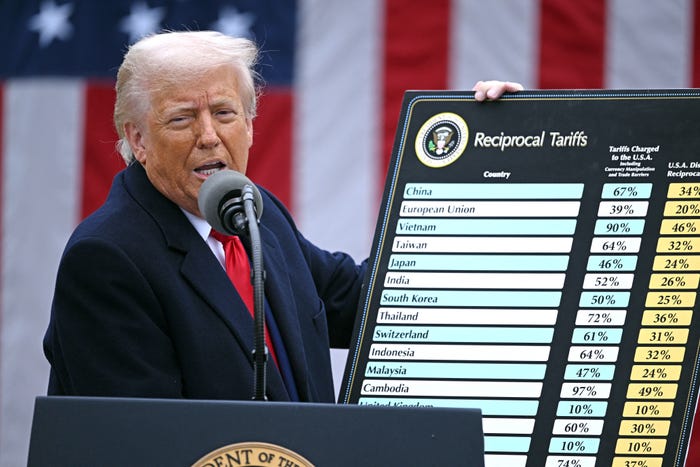## Trump’s “Liberation Day” Tariffs: A Celebration for Whom?
President Trump declared the imposition of tariffs on June 1st “Liberation Day” for American workers. But as Business Insider’s investigation reveals, this supposed liberation is coming at a steep cost for certain industries and workers, leaving many feeling anything but free.

Increased Costs for American Shoppers

President Donald Trump’s “Liberation Day” tariffs are here, and they could mean increased prices on a range of goods Americans rely on. The tariffs will apply to nations with which the US has the highest trade deficit, and take effect on April 9. The reciprocal tariff on goods from China is 34%, which is on top of the existing 20% tariff on Chinese goods, meaning the total effective tariff rate on Chinese goods now stands at 54%.
While some companies might choose to absorb some of the costs, consumers are set to shoulder most of the burden. Markets and consumers have already been feeling financial strains due to the ongoing uncertainty with Trump’s trade plans. The increased prices on impacted goods will likely lead to higher costs for American shoppers.

Companies Absorbing Costs vs. Passing the Buck
Some companies might choose to absorb some of the increased costs due to the tariffs, but it’s unclear how many will pass the buck to consumers. The impact will vary depending on the industry and the company’s business model. For example, companies that rely heavily on imported goods might be more likely to pass the costs on to consumers, while companies that have a more diversified supply chain might be able to absorb the costs.
However, consumers are likely to feel the pinch regardless of whether companies absorb the costs or pass them on. The increased costs will lead to higher prices for goods, which will ultimately affect consumer spending and overall economic growth.
Industry Reactions and Retaliation
Auto Industry Wins, But at What Cost?
The US auto industry has been a vocal supporter of Trump’s tariffs, citing the need to protect American jobs and industries. The United Auto Workers union previously lauded the president’s plan to place a 25% tariff on all cars and car parts imported into the US, saying it would bring more jobs back into the US auto industry. However, the tariffs will likely lead to higher prices for cars and car parts, which could offset any benefits to the industry.
Additionally, the tariffs could lead to retaliation from other countries, which could harm the US auto industry in the long run. For example, if other countries impose tariffs on US auto exports, it could lead to reduced demand and lower profits for American automakers.
Other Industries Bracing for Impact
Other industries that rely heavily on imported goods, such as technology and manufacturing, are bracing for the impact of the tariffs. The tariffs will likely lead to higher costs for these industries, which could affect their competitiveness in the global market. Additionally, the tariffs could lead to retaliation from other countries, which could harm these industries in the long run.
For example, the technology industry relies heavily on imported components, such as semiconductors and memory chips. The tariffs will likely lead to higher costs for these components, which could affect the profitability of technology companies and their ability to innovate and invest in research and development.
Global Fallout and Market Reactions
Markets in Turmoil
The announcement of the tariffs sent global markets plummeting. The Dow Jones Industrial Average fell over 250 points, or 1%, on Wednesday, while the S&P 500 index fell 0.7%. The Nasdaq composite index fell 0.9%. The yields on 10-year Treasury notes fell to their lowest level since October.
Leaders from around the world have vowed to take countermeasures in response to the tariffs, but details are scarce. The leaders of multiple countries, including Canada and China, have announced plans to impose tariffs on US goods in response to the announcement. The EU has also announced plans to impose tariffs on US goods.
The Trade War Escalation
The tariffs are part of a larger trade war that has been escalating over the past year. The US has imposed tariffs on a range of goods, including steel and aluminum, in an effort to protect American industries and jobs. China, in response, has imposed tariffs on US goods, including soybeans and pork. The tariffs have led to a decline in global trade and a surge in protectionism.
The risks of escalation are high, and the consequences could be severe. The tariffs could lead to a decline in global economic growth, higher prices for consumers, and a decline in competitiveness for American businesses. The US could also face retaliation from other countries, which could harm American industries and jobs.
However, it’s unclear whether diplomacy can prevail in the face of tariffs. The US and China have been engaged in trade talks for months, but progress has been slow. The tariffs could be a turning point in the talks, but it’s unclear whether they will ultimately lead to a resolution.
Conclusion
Conclusion
In the wake of Donald Trump’s “Liberation Day” tariffs, a targeted attack on American businesses has left a trail of devastation. The article examined who among U.S. companies, particularly those in the energy, agriculture, and automotive sectors, bears the brunt of these punitive measures. According to the data, companies such as Boeing, Caterpillar, and Deere & Company are among the hardest hit, with many facing significant revenue losses due to the tariffs. The article posits that these industries, which have historically relied on U.S. exports, now face a crippling blow to their bottom lines.
The significance of this topic cannot be overstated. The impact of Trump’s tariffs is far-reaching, affecting not only individual companies but also the broader U.S. economy. As a nation, we must confront the reality that these tariffs have far-reaching consequences, not just for American businesses, but for the global economy as a whole. The article’s findings emphasize the need for a nuanced approach to trade policy, one that balances national security concerns with the realities of global interconnectedness. Furthermore, the struggle to recover from these losses serves as a stark reminder of the importance of investment in American businesses and infrastructure.
As we move forward, it is imperative that policymakers and industry leaders prioritize collaboration and cooperation to mitigate the effects of these tariffs. We must work together to create a more just and equitable trade environment, one that supports American businesses and promotes sustainable economic growth. The road ahead will be long and challenging, but one thing is clear: the impact of Trump’s “Liberation Day” tariffs will be felt for years to come. As we look to the future, it is time to take a hard look at our trade policies and to ask ourselves: what does it mean to be a champion of American business in a rapidly changing global economy?
Conclusion for Unionjournalism The “Liberation Day” tariffs, a Trump-era move intended to curb Chinese trade, have ravaged American businesses, particularly those in critical sectors. The article highlights the devastating impact on companies such as Boeing, Caterpillar, and Deere & Company, who now face significant revenue losses. The consequences of these tariffs extend far beyond individual businesses, affecting the broader U.S. economy and the global economy as a whole. As we navigate this complex trade landscape, it is time to confront the need for a more nuanced and cooperative approach to trade policy.
